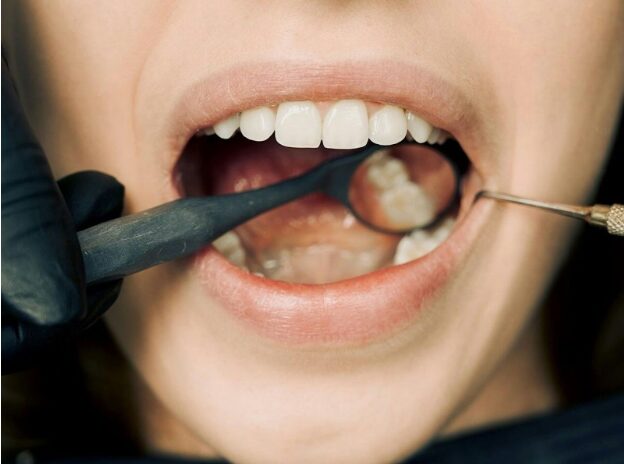If you’ve recently gotten a wisdom tooth extraction or a treatment that requires stitches, there are many restrictions to keep in mind. From focusing on soft foods to pausing your workout routines for the time being, the last thing you need is to see your dissolvable stitches hanging in mouth!
So if that’s been happening to you, it’s not the biggest thing to worry about. But you should be a little careful. In this blog, we’ll share everything you should and shouldn’t do with these hung stitches! Plus, we’ll dive into why the stitch might be out of its place in the first place.
Why is my stitch hanging in my mouth?
The reason your dentist put stitches in the first place is to help the healing process following a tooth extraction. These stitches are medical-grade and dissolve within a specific time frame after fully helping your recovery site to heal!
However, for it to hang, there are many reasons. Most of them aren’t a cause for concern, so that should be a relief to you. Here are the 5 reasons why you’re seeing dissolvable stitches hanging in mouth:
1. The suture thread is too long
One possible explanation for stitches from wisdom teeth hanging is that the suture thread used during your procedure was too long. It could be that the suture thread may have been cut longer than necessary during the treatment by the dentist or surgeon.
It’s also possible that the suture becomes loose and starts to hang down as a result of repeated mouth movements including eating, talking, and even simply shifting your jaw. The suture’s dissolvable nature could also lead to a sudden uneven breakdown of the stitch, separating one end while leaving the other intact.
2. The stitch thread is dissolving
It’s possible that stitches coming out of wisdom teeth could be lingering because the stitch thread is dissolving. As we mentioned before, oral stitches are dissolvable and don’t need any manual help to be removed.
Depending on the type of material used, dissolvable stitches are intended to slowly break down over time usually over a few days to a few weeks. But there have also been instances where wisdom teeth stitches came out after 3 days.
It’s saliva and the surrounding tissues containing enzymes that start to break down the suture material when the body goes through its natural healing process. Some of the factors that impact how quickly the stitch thread dissolves are:
- The area where the stitch is made,
- The kind of material used
- Individual immune system and healing process.

3. Thread was snagged during brushing
While maintaining proper oral hygiene is crucial following dental procedures, excessive brushing or flossing may unintentionally latch onto the stitches and cause them to come loose or tear down.
Particularly if the stitches are close to the gum line or in the spaces between teeth, the tiny loops of the stitch material are easily grabbed by the bristles of a toothbrush or dental floss.
Furthermore, stitches are more likely to snag if the dental work site has rough edges or if the stitches are not securely fastened.
4. Your gums are pushing it out
Your body produces new tissue to restore the damaged area while it heals. Sometimes the dissolvable suture is pushed closer to the gum tissue’s surface when new tissue grows and the stitches dry socket.
This occurrence is more likely to happen if the stitch is close to the gum line or if the surrounding tissue is swollen or inflamed. The stitch may appear to be sticking out of the gum line as the gums recover and the swelling goes down.
5. The stitch was loose beforehand
Of course, in very rare cases, it’s possible that the stitches were loose beforehand and got easily pulled out of the recovery site. It might also have been more likely to loosen if the stitch had too much slack or if it wasn’t securely fastened to the surrounding tissues.
The stability of the stitch can also be affected by the kind of suture material used, the dentist’s or oral surgeon’s skill, and the stitch’s position.
In addition, some oral behaviors like eating, talking, or even yawning can put a strain on the stitches and eventually cause them to loosen. Likely, stitches become even more loosened if you unintentionally touch or work with them with your tongue or fingers.
What to do if your stitches are hanging?
Here are several actions you can take if you discover that your dissolvable stitches are hanging in your mouth:
1. Gentle oral care
One of the first things you should do when your stitches start to hang is practice gentle oral care.
In a cup of warm water, combine around half a teaspoon of salt. This will create a warm saltwater solution. Spit it out after about 30 seconds of gently swishing this solution around your mouth. This can aid in cleaning the region and lowering the chance of an infection without affecting the stitches.
Make sure you use a toothbrush with soft bristles to gently clean your teeth and gums. Avoid brushing over your stitches to keep them from falling loose. Rather, use light circular strokes to thoroughly brush the surrounding areas.
While healing from stitches, try to limit your diet to soft, easily chewed foods. Foods that are firm or crunchy should be avoided since they may catch on the stitches and loosen them.
2. Trim the excess thread
Thoroughly wash your hands with soap and water before attempting to trim the stitches to lessen the chance of putting bacteria in your mouth.
To cut off the hanging thread, use a small pair of sterile scissors or nail clippers and ensure that the instruments you use are sanitized and free of any impurities or contaminants
Now, using clean hands or tweezers, gently grip the stitch’s hanging end and gently tug on it to make the stitch more visible and straight.
Then use the scissors or clippers to carefully trim the surplus thread as close to the gum line or dental work as you can to make sure you avoid the surrounding tissue.

3. Get a professional removal
Contact your oral surgeon or dentist to make an appointment for the removal of stitches as soon as you can. A dentist is best equipped to remove the stitches safely and efficiently due to their expertise and equipment without adding to the discomfort or issues of a hanging stitch.
The position of the stitches, the state of the surrounding tissues, and any indications of irritation or infection will all be evaluated before your dentist decides on the best course of action.
4. Wait for it to dissolve
It can take some patience to wait for stitches to dissolve because sometimes the wait becomes longer than anticipated. It’s advisable to avoid needless touching or removal of stitches to promote the best possible healing outcome and lower the possibility of complications.
The materials used to make dissolvable stitches naturally break down over time. Depending on the kind of material used and where the stitches are located, the time it takes for these stitches to dissolve can vary. Dissolvable stitches typically start to disintegrate a few days to a few weeks after they are put in place.
FAQs
While you technically can pull out dissolvable stitches, it’s not recommended by any medical professional. The reason this should not be done is because pulling it out manually will disrupt the natural healing process and slow down how quickly you get back to normal!
Stitches used during wisdom teeth extraction usually start to dissolve a few days to a few weeks following the procedure. That said, it’s not unusual for them to take a few weeks to completely disappear. It is also important to note that the time the stitches take to dissolve varies across every case.
Final Thoughts
Having dissolvable stitches hanging in mouth might be a frustrating, but manageable part of recovering from tooth extraction. But with the right post-operative care, this is something you won’t have to worry about. After all, stitches can hang in your mouth naturally as your body heals!
If you’re looking for the best dentists that make dentist appointments less scary, Premiere Dental is where it’s at. Book a free consultation with us in Abington, West Deptford, or Northeast Philadelphia and get your teeth the top-notch dental care they deserve!


